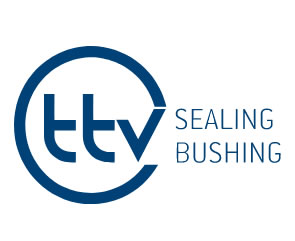
TTV GmbH +49 (0) 7303 - 92874 - 0 info@ttv-gmbh.de

| ProfilE | Design | Material | Hardness (Shore A) | Color | Temperature (°C)/temporarily |
|---|---|---|---|---|---|
| O-Ring | NBR | 70 | black | -30 to +100 / +120 | |
| O-Ring | NBR | 80 | black | -30 to +100 / +120 | |
| O-Ring | NBR | 90 | black | -30 to +100 / +120 | |
| O-Ring | HNBR | 70 | black | -30 to +130 / +150 | |
| O-Ring | FKM | 70 | brown | -20 to +200 | |
| O-Ring | FKM | 75 | brown | -20 to +200 | |
| O-Ring | FKM | 80 | brown | -20 to +200 | |
| O-Ring | FKM | 90 | brown | -20 to +200 | |
| O-Ring | FKM FEP-encapsulated | transparent/brown | -20 to +200 | ||
| O-Ring | EPDM | 70 | black | -40 to +110 / +130 | |
| O-Ring | EPDM perox. cross-linking | 70 | black | -40 to +150 / +170 | |
| O-Ring | VMQ | 70 | red | -50 to +200 | |
| O-Ring | VMQ FEP-encapsulated | transparent/red | -50 to +200 | ||
| O-Ring | PTFE | white | -200 bis +260 |
The designation of the O-ring consists of three elements:
The ttv resistance list provides information on the media resistance of the different materials. Technical rubber materials are subject to an exact formulation. In a comparison of the media to be sealed of all contained compound components, the polymer is the weakest component in terms of chemical resistance. The selection of the right material is therefore often limited to the correct choice of the base polymer. In practice, other formulation-related influences such as the type and quantity of plasticisers and fillers used can decisively change the properties.
Polymer compatibility alone is no guarantee for reliable sealing, but it is an important prerequisite.
| Ingredient | Percentage% |
|---|---|
| Rubber (polymer) | 40 |
| Fillers | 35 |
| Plasticisers | 20 |
| Auxiliary processing means | 1,3 |
| Durability means | 1,3 |
| Activators | 1 |
| Cross-linking agents | 0,7 |
| Catalysts | 0,7 |
Mix components of a sample recipe
| main Materials | Temperature-resistance | Range | |
|---|---|---|---|
| Nitril NBR | -30°C | +120°C | Hydraulic oil, grease, hydrocarbons, oils, lubricants, vegetable oil, water, butane, compressed air |
| HNBR | -35°C | +150°C | Ozone, UV, hot water, sulphurous oils |
| Chloropren CR | -40°C | +120°C | Air, ozone, water up to 80 °C, vegetable oils, oxygen, caustic soda, fatty alcohol, chlorine, refrigerant gas, alimentary applications, CO2 |
| Ethylen / Propylen EP | -45°C | +110°C | Food resistant (when peroxide cross-linked): water, beverages, use with inflammable liquids, vapour, diverse acids, caustic soda, glycols, ozone, hot water |
| Silicone VMQ | -60°C | +225°C | Low and high temperatures, air, oxygen, inert gas, low concentrated bases and acids, ozone |
| Fluorocarbon FKM | -15°C | +240°C | Good oil resistance, hydraulic liquids, solvents, use with inflammable oils and chemicals, ozone |
| PTFE | -150°C | +260°C | Excellent chemical resistance, electric insulator, low friction coefficient |
This closes the sealing gap at the base of the groove and at the contact or sealing surface. Thus a surface pressure is generated which makes a sealing effect possible. The maximum deformation of the O-ring cross-section depends essentially on the groove depth.
With the correct groove design and material selection, a seal can be used dynamically as well as statically, within the temperature limits of the material.
In the operating state, the pressure of the medium increases the deformation and thus the sealing function. When this pressure drops to "zero", the deformation almost returns to the installed condition.
The expansion in relation to the inner diameter should not exceed 5% when installed. Otherwise there may be a disproportionate reduction in cross-section and thus a severe flattening at the inner jacket. According to Guldin's rule, 1% elongation of the inner diameter results in 0.5% reduction of the shear thickness.
Further important information on O-rings can be found here.
The cord thickness D2 must always be greater than the installation space.
The compression is given as a percentage value. The compression is defined as the percentage of the cord thickness d2 by which it is compressed in the installed condition. The compression is therefore directly related to the groove depth. With the same percentage compression, the deformation forces increase with increasing cord thickness d2. To compensate for this, the percentage compression is reduced with increasing cord diameter.
If this cannot be ensured or if high pressures are to be expected, a material hardness as high as possible should be selected for the O-ring. Otherwise, gap migration / extrusion and thus destruction of the O-ring may occur.
Static sealing
O-rings are very well suited for sealing machine elements that do not move relative to each other. Pressures of up to 1000 bar can be sealed with O-rings, provided that the installation space is properly designed, the application is structurally correct and the correct material has been selected (in case of doubt, additional back-up rings should be used).
The installation spaces are the same for translatory (reciprocating) movement and for helical movement. In the application fields of hydraulics and pneumatics, however, they differ due to the different pressure ratios and lubrication conditions.
| PFEIL OBEN | typ of treatment | description | colour/ Aspect |
|---|---|---|---|
| Short term | Siliconisation | A silicone film is sprayed onto the parts to be treated | Glossy, greasily, transparent |
| Intensification of sliding | molybdenum disulfide coating | Molybdenum powder coating by tumbling | Silver-like |
| Long term | Talkumierung | Talcum powder coating by tumbling | Trocken, weiß |
| Pfeil unten | PTFE powder coating | PTFE powder coating by tumbling | Dry, white |
Important note
It is advisable to implement the clearance as small as possible. A larger seal clearance can result in the destruction of the O-Ring by gap migration.
O-Rings with a hardness of 90 Shore A allow for a slightly larger gap than standard-O-Rings in 70 Shore A.
Whether agricultural machinery, construction machinery, forestry technology, drive technology, mechanical engineering, automotive or aerospace, we are ready for your challenges. With our engineering solutions, we manage to offer added value in all decisive product parameters through solutions developed specifically for customers and applications. Get to know our competence and best examples in the most diverse markets.